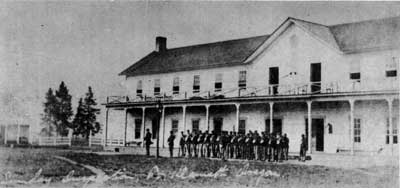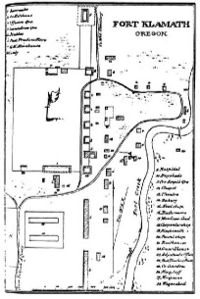Fort Klamath
|
Fort Klamath (1863-1890) - Established by two companies of soldiers under Major Charles S. Drew, 1st Oregon Volunteer Cavalry, on 5 September 1863 during the U.S. Civil War. Fort Klamath was an important post during Modoc, Snake and Piute wars. The majority of troops were removed in 1889 and the fort was finally left to a caretaker on 23 Jun 1890.
HistoryBuilt as a two company cavalry fort by Captain William Kelley and Company C of the 1st Oregon Volunteer Cavalry. It was located near strategic travel routes to California and Idaho and the new Oregon Central Military Road. The fort's main purpose was to oversee the Indian populations of the local area and to protect settlers and travelers. Originally built by Oregon volunteer troops it was garrisoned by Federal troops after the U.S. Civil War. The site chosen for the fort was ideal in that ample supplies of wood, grass and water were readily available. A rudimentary sawmill was hauled in and the construction of the fort was begun by Company C and a civilian contractor, David Linn. The first set of structures included barracks for two companies, four officers quarters, an adjutant's office, a guardhouse, an arsenal, a hospital, a bakery , storehouses for the quartermaster and two well built stables for the horses. The fort was of an open plan and not stockaded. The fort itself occupied about 1000 acres and a hay reserve occupied another 3000 acres. In Jul 1867 the volunteer troops were relieved by Federal troops of Troop A, 1st U.S. Cavalry. During the Federal period the fort was expanded to more than 40 buildings many of which were framed with fine, knot free pine. By 1885 the buildings included a fine new hospital, a library, a theater and an entertainment room with a billiard table. In July 1872 the garrison at Fort Klamath was instructed to return a band of Modoc Indians led by Captain Jack to the Klamath reservation. Captain Jack's band fled into what is now the Lava Beds National Monument in Northern California and took up nearly impenetrable positions in the lava beds. The Modocs could not be persuaded or driven from their positions and reinforcements were sent for. The new commander of the operation, General Edward R. S. Canby, received orders to cease offensive action against Capt. Jack's band and eventually began negotiations with them. At a Peace Commission meeting with the Modoc on 11 Apr 1873 the Modocs attacked the negotiators killing General Canby and Dr. Thomas. This atrocity signaled the end of negotiations and operations were begun to forcibly remove them. After several attempts and a disastrous ambush and massacre by the Modocs the acting commander was relieved by General Jefferson C Davis and the army finally gained control of the situation. On 4 Jun 1873 Capt. Jack was captured, reportedly still in General Canby's uniform, and removed to especially built stockade at Fort Klamath. A courts martial was convened 5 Jul 1873 and six Modoc were tried for murder, Capt. Jack and three others were convicted and hung on 3 Oct 1873. Their graves are marked on the present day fort. The Modoc War cost the lives of five officers and sixty enlisted men and General Canby was the only General Officer to lose his life in any of the Indian wars. In the years after the Modoc War, Fort Klamath became the social center of the area and the post settled into a peacetime routine. In 1880 General Irvin McDowell called it "The most beautiful frontier post in the nation" and by 1885 the post was at its zenith with over 40 well built buildings, mostly painted white. It had the look of a very proper and prosperous post. The troops were kept busy with patrols and drills but there was little fighting to be done. In 1886 President Grover Cleveland declared the post "useless for military purposes" and the long process of closing down Fort Klamath began. The post was officially closed 9 Aug 1889 and the garrison departed that day leaving behind a caretaker detachment led by Lt. William C McCammon, 14th U.S. Infantry and nine enlisted men. This detachment endured a brutal winter that saw buildings collapse under the weight of snow. They departed Fort Klamath on 23 Jun 1890 leaving agent John F Loosley in possession. In the following years old Fort Klamath was used for the occasional National Guard maneuvers and annual Fourth of July celebrations. Around 1900 the land was alloted to the Indians and they began to remove the buildings for their own use and the land fell into private ownership. Recently several of the original buildings have been located. Current StatusOregon Route 62, Crater Lake Highway, bisects the old fort grounds and a part of the grounds on the west side of the highway is a Klamath County Park dedicated in August 1973. The road actually runs right where the line of officer's quarters once was. Other parts of the former Fort Klamath are on private property. The County Park is dedicated to the fort has a reproduction of the guardhouse that serves as an excellent museum with artifacts and interpretive displays that describe the fort. Also reproduced on the grounds are the graves of Capt. Jack and his three accomplices. Kevin Fields was manning the museum on the day of our visit and help us greatly with information about Fort Klamath and other forts in that part of Oregon.
Sources:
Links:
Fortification ID:
Visited: 29 Jun 2008 Picture Gallery
| |||||||










